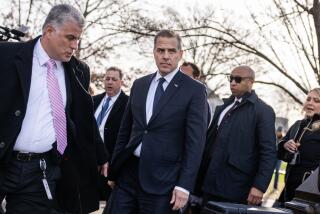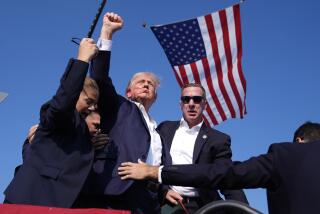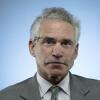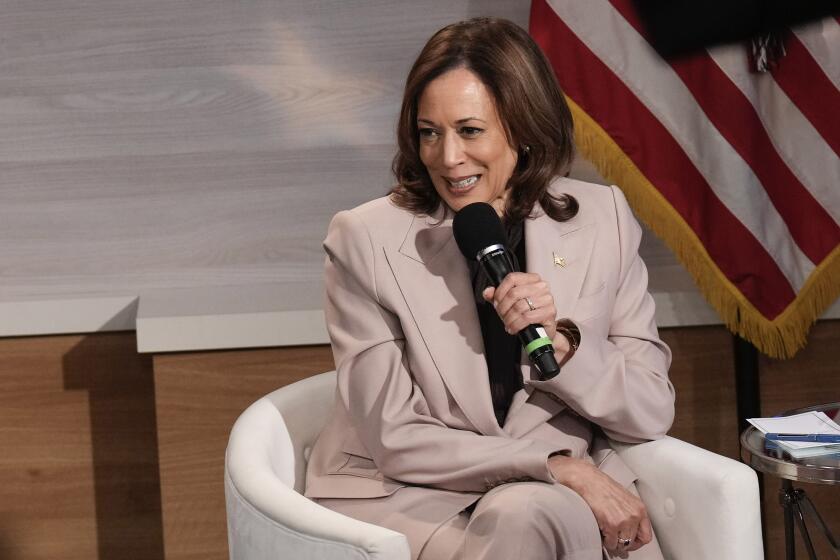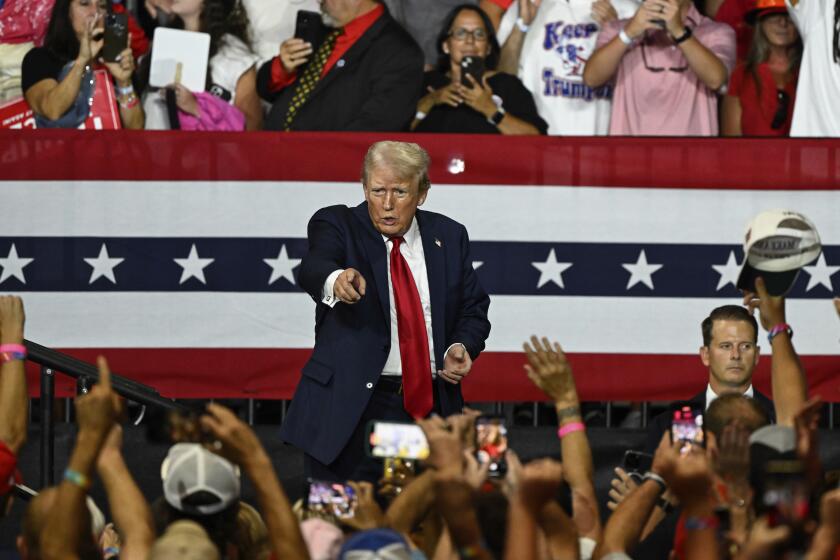No Rest for the Elected
From his third-floor law office in Beverly Hills, Raymond Boucher has one of the better vantage points on the nation’s politics. Here is what he sees: a parade of candidates that seemingly snakes the length of Wilshire Boulevard.
And not just contestants in the 2006 elections. Boucher, vice president of the Consumer Attorneys of California, has already met with a dozen or so hopefuls who plan to run in 2008. And three or four aspiring office-seekers mapping out campaigns for 2010.
“You talk about a political ‘season,’ ” said Boucher, who helps his group distribute millions of dollars in campaign funds to state and federal candidates. “Right now we’re at the point where we’re talking politics every single day, almost 24 hours a day.”
The permanent campaign -- a never-ending cycle of fundraising, polling and candidate positioning -- has been a growing part of American politics for a generation, even before the term was popularized in a 1980 book of that title by journalist Sidney Blumenthal.
But those immersed in the election system -- candidates, fundraisers, campaign consultants, issue advocates -- say that in just the past few years the pace has grown even more relentless, to a point where the notion of a political “off-season” seems every bit as quaint as straw boaters and torchlight parades.
President Bush is currently embarked on a 60-day blitz to pitch an overhaul of Social Security, a campaign virtually indistinguishable from his election tour last fall.
He has used the same camera-friendly backdrops, the same buoyant crowds screened for potential dissenters, even some of the same lines.
The White House is hardly alone in treating November’s election as just one more event on a 24/7 campaign calendar.
In California, the San Manuel Band of Mission Indians, which has bitterly feuded with Gov. Arnold Schwarzenegger over gambling issues, began airing TV spots attacking the governor a month after the November vote. “If you have the ability to define yourself with your own words, that’s what you need to be doing,” said Deron Marquez, tribal chairman.
More recently, unions representing California’s teachers and nurses have joined the assault on Schwarzenegger, pummeling the governor with radio and TV spots that will probably continue if he seeks reelection.
Schwarzenegger has retaliated with radio and television spots assailing his detractors. At the same time, he is raising record sums of money as he threatens to call a special election for November if lawmakers fail to adopt his proposals to reshape Sacramento. It would be the sixth statewide vote in three years.
Once a date is set, “You’re looking at the prospect of a ballot crowded not just with Arnold’s proposals, but the Democrats’ proposals and interest group proposals,” said UC Berkeley political scientist Bruce Cain.
Indeed, roughly 80 prospective initiatives have been submitted to the attorney general for review in Sacramento, a record.
There are several reasons for the ceaseless campaigning, starting with the dukes-up mentality -- “hit or be hit,” as one political operative put it -- that has become instinctive for strategists in both major parties.
The nation’s near 50-50 partisan divide is another factor, working like the chicken and egg: Greater polarization among politicians leads to greater polarization among the public, which fuels further polarization among the politicians.
But the main reasons for today’s blitz of all politics all the time are money and media.
The cost of campaigning continues to rise with each election, forcing candidates to raise ever greater sums.
In addition, the rise of the 24-hour news cycle, fueled by increased competition between cable TV networks and the proliferation of political outlets on the Internet, means an insatiable appetite for political news -- or, at least, something new to talk about.
“As a consequence, there’s a temptation, an incitement, for politicians to be active all the time,” said Jim Jordan, a Democratic campaign strategist in Washington, who acknowledged that political professionals often egg on their clients. “Those of us in the business do what we do, and therefore we encourage our bosses to do it with us.”
In California, the trend has been accelerated by term limits, which produce unceasing churn in Sacramento.
“People are already thinking about reelection as soon as they’re elected, or moving to another position and wanting to be first out of the box,” said Democratic consultant Gale Kaufman. “It costs so much money and it’s so hard to get name recognition statewide, you can’t wait until the last minute to announce and get started.”
To some, there is virtue in a system that keeps candidates in perpetual campaign mode -- more political discussion and a heightened awareness of the stakes involved. The 2004 presidential campaign, one of the longest and most heated in recent memory, produced a voter turnout of roughly 60%, the highest in 36 years.
But the overwhelming sentiment is that much more has been lost than gained.
One result, some analysts say, is legislative gridlock that makes it nearly impossible to forge a bipartisan consensus on any major issue. With at least one eye cast on the next election, issues are no longer problems to be solved through compromise but bludgeons to be used against the opposition.
“When you’re going to fundraisers every night, you’re going to be in a campaign mode every day,” said Douglas Bailey, a Republican strategist who opened his Washington campaign consulting firm nearly 40 years ago. Instead of congressional colleagues, he said, members of the opposite party have become adversaries and every day “is a constant war.”
Bill Zimmerman, a Democratic advertising consultant in Santa Monica, agreed. “As long as we have two Americas, one red and one blue, as closely divided as we have now, we’re going to continue having the arms race we see,” he said. “And as happens in any arms race, it will escalate.”
Sen. John F. Kennedy of Massachusetts declared his White House ambitions on Jan. 2 of the presidential year 1960. True, Kennedy had been angling for the office ever since he was passed over for the second spot on the 1956 Democratic ticket. But Kennedy’s offhand announcement, in response to a reporter’s question, stands in stark contrast to the years of public ground-laying that go into today’s presidential contests. Already, several candidates are actively campaigning for 2008.
The cool, cerebral Kennedy benefited mightily as the first candidate to master the fledgling medium of television. But that was comparatively easy when there were just three major networks, which served as the main source of political news for the country. Today’s panoply of media outlets -- the national TV networks, 24-hour cable shows, talk radio, the Internet -- have drastically changed the nature of campaigning, from the White House down.
“The generation of President Bush’s father had politics as a one-news-cycle-a-day event,” said Rich Bond, a GOP strategist who headed the Republican Party during President George H.W. Bush’s 1992 reelection bid. “You would gauge who ‘won’ the evening news on a day-to-day basis and adjust accordingly. We now have an hour-by-hour or event-by-event news cycle where nobody’s ever off duty.”
Worse, much of what constitutes political “news” these days is scarcely more than bickering and name-calling, which strikes sparks but provides little in the way of illumination.
“What feeds the permanent campaign is conflict, controversy and contrast,” said Don Sipple, a GOP ad man whose client list includes Schwarzenegger and George W. Bush, when he was Texas governor. “The press is always more interested in those elements than pure substance or education.”
Of course, it is the main actors -- the candidates and their strategists -- who drive most of the political coverage. And the overriding tone of most major political campaigns these days is negative --all the more so as consultants produce edgier ads designed to cut through the increased clutter.
In 1988, the elder Bush won the White House by savaging Democrat Michael S. Dukakis, whose failure to fight back was burned into the minds of political practitioners everywhere. Four years later, strategists for Bill Clinton created a much-celebrated “war room” that turned rapid response into an art form. Today, the attacks, counterattacks and counter-counterattacks zip back and forth as quickly as they can fly over the Internet, or surface on cable news shows.
As the campaign cycle perpetuates itself, the ways and means of election season also have become a standard part of year-round governing.
On Capitol Hill, one of the first tasks undertaken by Sen. Harry Reid of Nevada, the new Democratic leader, was establishing his own “war room,” led by veteran communications strategist Jim Manley.
By 9:30 every workday morning, Manley’s staff prepares a set of talking points for distribution to Democratic press secretaries, sympathetic radio talk show hosts, bloggers and other allies across the country.
“The intent is to leave no attack unchallenged,” Manley said. “You need to respond not only to the day’s news, but get ahead of the day’s news. It’s become very similar to what we’ve seen in presidential campaigns, with the give and take, the cut and thrust.”
Issue advocacy and third-party groups have taken their cues from the candidates as well; partisans have already spent millions of dollars trying to shape opinions on Social Security, before Congress even has a bill to consider.
The advertising goes well beyond the efforts of a decade or so ago, when opponents of Clinton’s healthcare plan used a few strategically placed cable TV spots -- the “Harry and Louise” ads featuring a couple fretting over excess government regulation -- to stir up concern in Congress.
“Those were intended to show insider players the threat of what you could do with [national] advertising,” said Bill Carrick, a veteran Democratic ad consultant. “Now people are actually going out and doing it.”
In the last dozen or so years, the cost of federal elections has more than doubled--exceeding $4 billion, according to the Center for Responsive Politics, which tracks money and campaigns.
Evidence suggests that the costs of state and local campaigns have soared as well.
Darry Sragow, a Democratic strategist in Los Angeles, said he tells first-time candidates for statewide office they should count on spending 20 hours during the week, and their entire weekend, courting donors and raising money. Years ago, he said, fundraising took up a fraction of that time.
A major reason apart from the rising cost of campaigns is the country’s close partisan divide -- not just in Washington but in state capitals nationwide.
Alan Rosenthal, a Rutgers University expert on state legislatures, estimates that at least one house of government is up for partisan grabs in more than half the states. (He excludes California, where Democrats control the Assembly and state Senate by comfortable margins.)
Election spending is soaring “because neither side knows how much it takes to win a competitive seat,” Rosenthal said. And when just a handful of seats can tip the balance in partisan control, “You’re going to raise as much as you can. Suppose you don’t and you lose. How do you justify it?”
Still, for all the expressions of concern, not one of the dozens of people interviewed for this article suggested there was any reason to believe the cycle of 24/7 politics would slow -- much less end -- anytime soon. To the contrary, all suggested the breakneck pace would only increase.
Indeed, the 2008 presidential campaign is already well underway, with candidates hiring strategists, courting donors and calling on the early-voting states of Iowa, New Hampshire and South Carolina.
Jordan, who worked for Sen. John F. Kerry (D-Mass.) in the last presidential election, said that for the first time in more than 50 years, there was no front-runner for the nomination of either major party.
“You’ve got a limited pie for money and supporters that’s got to be split up an awful lot of ways,” Jordan said. “No would-be candidate wants to fall behind.”
*
To see recent Column One articles, visit latimes.com/column one
More to Read
Get the L.A. Times Politics newsletter
Deeply reported insights into legislation, politics and policy from Sacramento, Washington and beyond. In your inbox three times per week.
You may occasionally receive promotional content from the Los Angeles Times.
